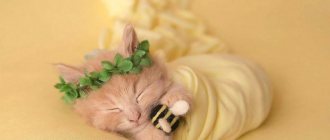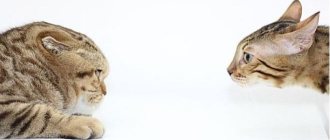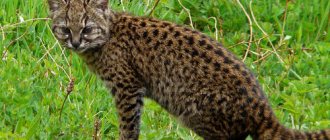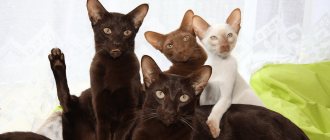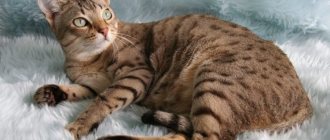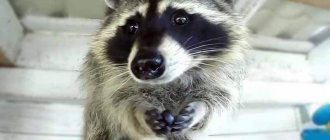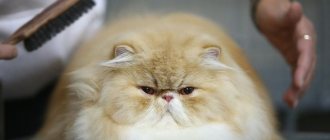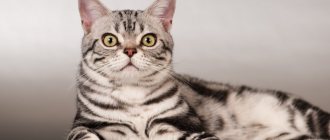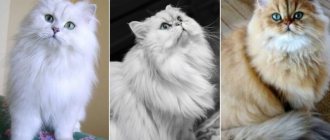Origin story
Himalayan cats are not a gift from nature, but the fruit of hard work.
The first experiment was carried out in 1920 by Swedish and American breeders, but they did not achieve impressive results. The second attempt was in 1931. Breeders tried to cross a black Persian and a Siamese cat. Kittens were selected from the litter that outwardly resembled “Siamese” in color (i.e., having a dominant gene), and the work continued. And only for the third time, American Margaret Gowford received new offspring: there was only one kitten in the litter, but what a kitten! Blue-eyed, long-haired, with the color of a Siamese cat. In 1955, color-point kittens were born in the UK, and in 1957 the breed received official recognition by the CFA Cat Fanciers Association. The International Cat Association approved the standards in 1979, and in 1984 the Persian and Himalayan breeds were combined into one and given its own name.
The first Himalayan cats appeared on the territory of our country only in the 1980s, but they gained popularity in the late 90s.
Why exactly the “Himalayan” breed? The cats received this name due to their external similarity to the Himalayan rabbits, bred back in 1857. Both cats and rabbits have a special gene called Himalayan - a section of DNA that controls the transformation of the coat color on the prominent parts of the body (tail, paws, ears and muzzle) to brown tones. The remaining areas of the body remain unchanged beige or white.
It is interesting that European felinologists do not recognize Himalayan cats as a separate breed, but consider them to be typical color-point Persians.
Video
* We invite you to watch a video about the Himalayan cat . In fact, in front of you is a playlist in which you can select and watch any of 20 videos about a given cat breed by simply clicking on the button in the upper right corner of the window. In addition, the material contains quite a lot of photos. By looking at them you can find out what a Himalayan cat looks like.
Rate the material!
[Total votes: 1 Average: 5]
The Himalayan cat is a fairly large breed with long hair and a special color. Her large sky-blue eyes give her incredible charm. Despite its name, the animal has nothing to do with the Himalayas, being the result of long-term work by breeders from the USA. This beauty will not leave anyone indifferent. The cat is very affectionate and sociable, an ideal pet for any family.
Standards
The body of these long-haired “purrs” is massive and tightly built, with good bone structure. The first impression is that of a powerful and strong animal. Males are larger than cats and weigh on average 5-6 kg, while females weigh 3.5-4.5 kg and are somewhat more graceful. How big an animal will grow depends, first of all, on heredity.
There are several standards for this breed: the basis is the CFA metric, common to both the Himalayans and the Persians; for the convenience of breeders, the TICA metric was developed.
| Standard | Description |
| Head | Round, smoothed, wide, dome-shaped skull. In proportion to the body of medium to large size. The bite is correct. The jaws are powerful and strong. The cheeks are plump, the forehead is convex. |
| Ears | Small in size, rounded at the tips, far apart from each other. |
| Eyes | Expressive, round, planted far apart. Color - from light blue to dark blue. |
| Chin | Strong, developed. The neck is well-fed and wide. |
| Nose | Small and short, wide, snub-nosed. |
| Body | Round and strong, equally massive in both the croup and the shoulders. Smooth and short back. The ribs and belly are rounded, but there is no feeling that the cat is fat. |
| Paws | Large, round. |
| Tail | Short, straight, without bends or kinks. Very fluffy. |
Disadvantages affecting show scores: lack of fangs in adult cats; long back; bad wool; "Roman nose; narrow head; close-set eyes. Animals with strabismus, malocclusion (undershot or underbite), kinks in the tail, or muzzle asymmetry are not allowed to participate in the competition.
Photo of a Himalayan cat
Reviews about the breed
Judging by reviews from owners, Himalayan cats are ideal companions. They are calm, balanced, affectionate and incredibly attached to humans.
In most cases, Himalayan cats get along well with other animals, all thanks to their calm disposition.
Himalayan cats are often described as smart and clean animals.
This breed of cat is very people-oriented, becomes attached to all family members and tries to participate in all human affairs.
Himalayan cats can be owned by anyone who is not afraid of the length of the coat and the need to care for it. And also the fact that now many things in the house will be covered with wool to a greater or lesser extent.
Who should not get a Himalayan cat:
- Himalayan cats, as already mentioned, cannot tolerate loneliness, which means they are not suitable for busy people and those who are not going to pay a lot of attention to their pet.
- An equally important point is care. Would everyone agree to devote time to their cat every day? Long hair is regularly combed, tear ducts are cleaned, washed and many other hygiene procedures are performed.
- Himalayans are absolutely not suitable for people who expect round-the-clock entertainment from their cat. These aristocrats cannot be teased, tied to adventures or forced to play. They need a calm, measured life on the couch next to their beloved owner.
- Allergy sufferers and fans of cleanliness should also consider a different breed; a certain amount of hair, even with daily combing, will remain on the furniture.
Colors
The coat of Himalayan cats is very pleasant to the touch: it is so thick, soft and silky that you want to stroke them without stopping. The decorative part is strong, despite the fact that it is very thin.
By the age of three, Himalayan cats finally develop their color. At the same time, the shades may be different, but the overall picture will always be the same: color point, repeating the pattern on the Siamese coat.
The Himalayans have a gene in their genome that once gave their ancestors, Siamese cats, their typical color. The point is this: the color of the fur, skin and iris of all mammals is formed under the influence of melanins. These pigments with an irregular structure are formed under the influence of UV rays during the oxidation of the cellular protein tyrosinase. In the case of Himalayan cats, tyrosanase is produced, but becomes extremely sensitive to changes in body temperature. That is why the “prominent” parts - paws, tail, ears and muzzle - have a rich, bright shade, and the main coat color is lighter.
Types of colors:
- Color point is a classic Siamese color: the dark parts of the body are painted a uniform dark color, the contrast is clearly visible;
- Lynx (tabby point) - the animals’ eyes seem to be lined with a dark pencil, there is a pattern on the forehead in the form of the letter “M”, dark areas in the form of stripes, the tail and ears are light on the inside.
Additional color can be lilac, blue, cream, red-red, brown, dark chocolate. The rarest colors are: choclit point (chocolate), cream point (cream), blue cream point (bluish-cream), the most expensive is lilac point (purple or lilac). There is also a so-called brindle color, but since it has only now become of interest to breeders, cats with this color can literally be counted on one hand.
The bright spot on the face should have clear boundaries and not “creep” onto the chest, neck and back.
Price and where to buy a kitten of the Himalayan color-point breed
You can buy a Himalayan color-point kitten in nurseries in Moscow, Kyiv or Minsk. Its cost depends on gender, age and color - from 10,000 rubles and above. Although a pet-class kitten may cost less. A kitten with a chocolate or lilac point has a higher cost, because... This color is more difficult to obtain.
When choosing a kitten, you should make sure that it is healthy, moderately playful and active. You should not adopt a kitten younger than 12 weeks, as it still needs mother's milk. By the way, with age, a cat’s points can become brighter.
Be sure to ask for photos of the cat's mom and dad and documents to make sure that you are purchasing a Himalayan cat and not an ordinary Persian.
Character and behavior
Himalayan cats may look somewhat warlike - but this is only at first glance. In fact, they are the kindest creatures who need human attention and affection. Their favorite place is the lap of their beloved owner. Balanced and calm, the Himalayan cat is at the same time extremely sociable and playful.
Their intelligent disposition allows them to make friends with all family members and be friendly to guests: they do not hide from strangers, but come out to greet them, sniff them and ask for a portion of affection.
They adore children: they will happily play with both children and older ones, but they will never allow themselves to let out their claws. If the little one tries to pull the “Himalayan” by the tail or throw toys at it, it will turn around and go to a safer place.
The Himalayans have a reserved interest in other animals. They get along quite peacefully with cats and dogs, but with smaller creatures - hamsters, birds, etc. – you shouldn’t leave them: these shaggy “buns” also have a hunting instinct.
Due to their unique body structure, they cannot jump high, so you don’t have to worry about the owner’s vases and souvenirs on the sideboard shelves. But you can’t deny their curiosity: they come running to any noise in the apartment and carefully explore all new corners and objects.
But what Himalayan cats do not like is very loud sounds and noise. During noisy parties, animals prefer to hide in secluded corners. They also do not tolerate loud shouts, and if the owner begins to reproach him loudly, he will be greatly offended.
In which country is the cat a sacred animal?
GreeceEgypt
Among the “minuses” we can highlight the following. Firstly, their famous and so beautiful coat requires careful care every day. If you don’t comb it on time, there will be pieces of fur flying around the apartment. Secondly, with age, “Himalayans” become very lazy. Thirdly, their sociability sometimes begins to infuriate them: if a cat “needs” to talk, it will not calm down until you take it in your arms and talk to it for a while. And this can happen both during the day and in the dead of night. Please note: even a ringing intercom, or slamming a door, or a dog barking provokes a cat to meow loudly.
If you come home from work, your cat will meet you at the door and immediately begin to “tell” you about how her day went and how she missed you.
You are unlikely to be able to find a Himalayan kitten on the street, so if you want to get a purebred animal, contact private breeders or a nursery. The cost of one individual can vary from 30 to 60 thousand rubles.
Purchasing a Himalayan cat and cost
You should buy a Himalayan kitten no earlier than three, and preferably four months. Professional breeders will never offer new owners an animal younger than this age.
If you purchase an animal for participation in exhibitions or breeding, then the price will be higher than that of a pet class - a pet for the home. But at the same time, you will be given a package of accompanying documents - a purchase and sale agreement and the kitten’s metric or a finished pedigree.
Any animal from the nursery is sold only with a veterinary passport, which contains notes on deworming and vaccinations against common infections and rabies made at a state veterinary clinic.
The pedigree is the main document, the cat’s passport. Only if it is available can the pet participate in felinological shows and exhibitions. Kittens born from a cat without a pedigree, even from a purebred Himalayan cat, will never be registered as representatives of this breed.
When purchasing a Himalayan kitten, you should pay attention to:
- The reputation of the nursery where the baby was born and raised.
- The breeder has a certificate of membership in one of the felinological organizations.
- The level of maintenance of cats in the nursery is cleanliness, absence of odors and overcrowding of animals.
- The appearance of the baby will say a lot about his health. He should have shiny fluffy fur, be active and playful. There should be no watery eyes, no discharge from the nose, or bad breath.
The cost of a baby Himalayan starts from ten thousand rubles, depending on the class of the animal and the purpose of acquiring the animal by the new owners. This indicator varies quite widely depending on many factors:
- uniqueness of the kitten;
- reputation and fame of the nursery;
- the location of the nursery, its distance from the center;
- the presence of awards and titles from the baby’s parents (usually the father);
- rarity of colors (feline blue, lilac or chocolate shades are more highly valued);
- the animal’s exterior and its professional assessments;
- gender and age of the kitten.
Gallery of Himalayan cats:
Care instructions
Purchase the following accessories for grooming: a metal comb with fine teeth, a brush with natural bristles, a slicker brush, cat shampoo, toothpaste and a brush for cats, and coat conditioner.
Wool
Thick and long hair must be combed regularly, otherwise tangles cannot be avoided (it is better to cut the hair around the anus short so that feces do not stick to it). In spring and autumn, during molting - 4-5 times a week, in winter and autumn - 3 times. Brush the cat according to the hair growth, without touching the face and neck, first with a comb, then with a slicker brush, and finally with a brush with natural bristles. Himalayan cats love this procedure very much. As is swimming, by the way. Soaking in warm water is a real pleasure for them. But don’t bathe them too often: once every 3 months is enough.
Claws
The claws on the front paws are cut 2 times a month, on the hind paws - once. Don't forget to buy your pet a scratching post.
Eyes
The eyes are wiped every 2 days with a special lotion.
Teeth
The teeth of the “Himalayans” should be given special attention: since the jaw bones are deformed due to mutations, tartar often grows on them, the gums become inflamed, and the teeth begin to loosen and rot.
Therefore, it is necessary to clean the oral cavity once a week, using a special silicone brush and therapeutic and prophylactic paste (Shot.Caller, Hartz, Orozyme, Cliny, Beaphar, TropiClean and Zubastik gels). If you don't have the paste on hand: moisten a piece of gauze with chlorhexidine and wipe your pet's gums.
Ears
There is no need to be overzealous in cleaning your ears. It is enough to do this once every 30-40 days, or as it gets dirty. Apply a little chamomile infusion to a cotton sponge and wipe the sink. You can’t bury anything inside! Don't ignore grooming: excess fur in the ears can cause otitis media.
Expert opinion
Dusheba Vera Ivanovna
In 2010, she graduated from the Moscow State Academy of Veterinary Medicine named after K.I. Scriabin with honors, specializing in veterinary medicine. I regularly attend veterinary conferences, congresses, and webinars.
Since shedding is natural, and cats swallow a lot of their fur, give your pet a special paste to remove excess hair from the stomach. This product is cheap, but will bring a lot of benefits.
Reproduction of Himalayan cats
The breed is considered difficult to breed because the color may not be fixed in subsequent generations. The probability of marriage is approximately 40%, so animal owners often turn to specialized nurseries for help. As a rule, a related individual is selected for mating so that the breed characteristics are fully preserved. The owners of Himalayan purrs negotiate this possibility when purchasing a kitten from professional breeders.
Himalayan cats may start wanting a male cat before puberty if they are not neutered.
If you plan to sell kittens, you need to register your nursery with an international felinological organization. To do this, contact the felinological center and submit documents - an application, pedigree and veterinary passport for each existing animal, a diploma of appropriate education or completion of special courses (veterinary, medical).
Peculiarities of breeding of Himalayan cats:
- first mating of cats at 8 months, males at 10 months (time of puberty);
- the partner for mating must be completely healthy and not aggressive, well-groomed and purebred;
- gestational age - 63–72 days (about two months);
- There are 2–4 blind kittens in the litter.
Babies have a uniform color - white or cream. Dark markings appear after 3-4 weeks, the final color is formed by the age of 2 years.
If there are no plans to breed Himalayans, the pet will be castrated or sterilized. The optimal age for surgery is 5–6 months.
Catering
Kittens (up to 6 months) and pregnant cats are fed at least 4 times a day, adolescents (from 6 months to one and a half years) - 3 times, older ones - 2 times. The owner chooses the food: natural dishes or dry and wet food. You can't mix them! It is allowed to use dry and wet food of the same brand.
Natural products
General nutrition rules:
- Check foods before giving them to your cat. Inspect meat and fish for parasites, do not skimp.
- Cats should not be fed fried food.
- Be sure to cut dense and hard food into pieces to prevent your cat from choking.
- Alternate foods. You cannot feed the animal only meat or only porridge.
The diet should include:
- Meat: rabbit, chicken, veal, lamb, turkey. Duck, quail, lamb and pork are prohibited: they are too heavy for a cat's stomach. It is allowed to give liver, hearts and ventricles. The meat is stewed, boiled or, after defrosting, doused with boiling water. Give daily.
- Fish (hake, salmon, trout, taimen, pink salmon) contains amino acids, lipids, magnesium and phosphorus, but you should not get carried away with it. Otherwise, the animal will have kidney problems. Bones must be removed. Freshwater fish accumulate toxic substances, so it is better to feed your cat saltwater fish. Give no more than once a week.
- Oil (vegetable and butter) is a source of vitamin E and fats. It is added to the prepared porridge half a teaspoon per day.
- Dairy products (kefir, fermented baked milk, natural yogurt, sour cream, cream) are rich in protein and calcium and are easily digestible. Of the eggs, the cat is given only the yolk. Give 4-5 times a week.
- Cereals (oatmeal, millet, rice, rolled oats) are boiled in water. It is recommended to give every other day. Liquid semolina porridge is given to babies up to 3 months old.
- Vegetables replenish the body's needs for fiber and serve as a source of vitamins and improve the functioning of the gastrointestinal tract. The diet includes carrots, beets, zucchini, pumpkin, asparagus, cucumbers, greens (green onions, spinach, celery, basil). Give every day.
- Fruits (apples, melon) are a treat. Give 1-2 times a week.
- Sprouted grains of oats or wheat: place a container with sprouts next to the bowl, and the cat will treat itself at the right time.
Clean water at room temperature should always be freely available! Change it twice a day: morning and evening.
You cannot give:
- Peas, legumes, potatoes and cabbage: they cause increased gas formation.
- Seasonings, ketchup, adjika and other sauces: they are too hot and salty.
- Bones, meat trimmings, chicken skin, fat: they have no nutritional value - they are ballast for the stomach. The bones can puncture or scratch the lining and larynx.
- Sausages, sausages, sausages, ham, human canned food.
- Snowballs, yoghurts with additives, ice cream: they contain so much sugar that it negatively affects the functioning of the pancreas and causes the development of diabetes.
- Baked goods (bread, buns, cookies) are poorly digestible and have no benefit.
- Tea: The caffeine in its composition has an stimulating effect, causing hyperactivity and anxiety.
Photos of Himalayan cat kittens
Recommended food
Among industrial feeds, we can recommend the brands Bozita, Pronature Holistic, Barking Heads.
Below are recommended premium foods, links with food names are clickable. Using them, you can, within our website, read descriptions of food and read reviews from owners of the Himalayan cat breed.
| Premium | Economy | Zconom |
| Pro Plan | Sheba | Gourmet |
When choosing food, always consider the characteristics of your pet. Oriental breeds and “Siamese” eat a lot, so the diet should be more dietary. Long-haired cats need maximum fiber, kittens and adolescents need more high-calorie food. Take into account concomitant diseases.
Maintenance and care
Since the Himalayan cat has long and thick hair, it needs regular, almost daily brushing. A cute flattened face affects the functioning of the tear glands, so these cats have profuse lacrimation, their eyes need to be cleaned every day, for this you will need a cotton pad soaked in a special solution for cleaning the eyes. You can find such a product in any pet supply store. This breed's sebaceous glands are also quite active, which is why they need regular bathing. Fortunately, the Himalayan Persian loves water treatments, so you should not have any difficulties with bathing. Also, do not forget to regularly clean your pet’s ears and take him for a consultation with a veterinarian to get the full range of necessary vaccinations. Once every six months, the cat should be dewormed and treated for fleas.
Diseases
Himalayan cats adopted many features and health problems from Persians. Snoring and grunting at night is not a reason for panic, but just a feature of the structure of the respiratory system. But don’t allow stressful situations!
If the cat becomes very frightened or nervous, it will have problems breathing - it becomes noisy and difficult. Don't get colds! Even small drafts cause bronchitis and pulmonary pathologies in the Himalayans.
The most common ailments are:
- Baldness (it is caused by severe shocks and experiences: the animal begins to comb or bite its body, tearing out shreds of fur);
- Skin asthenia (the skin becomes thinner and sags, folds form on it, which easily tear);
- Obesity (due to a sedentary lifestyle and an incorrectly composed diet);
- Cataract (hereditary disease);
- Inflammation in the sinuses (pathogenic microbes accumulate in the nose);
- Polycystic kidney disease (cysts grow around the kidneys).
Cats are susceptible to parasites and easily pick up viruses, so give deworming medications on time and get all the necessary vaccinations. “Himalayans” tolerate castration and sterilization calmly: their character remains just as calm and friendly.
Expert opinion
Dusheba Vera Ivanovna
In 2010, she graduated from the Moscow State Academy of Veterinary Medicine named after K.I. Scriabin with honors, specializing in veterinary medicine. I regularly attend veterinary conferences, congresses, and webinars.
The following symptoms indicate an illness: refusal of food or water; weight loss; changes in behavior (unusual lethargy or aggression); repeated vomiting or diarrhea; presence of blood in the urine; swelling of the eyelids; purulent discharge from the eyes; cataract. If you notice anything from the list, take your pet to the vet immediately!
Health of the Himalayan Colorpoint
Himalayan cats have inherited diseases such as polycystic kidney disease and urolithiasis . Therefore, it is better not to experiment with food, but to opt for high-quality premium or super-premium complete food.
Due to their flattened nose, pussies may have problems with lacrimation , have difficulty breathing and have weak immunity to colds .
Well, like the Persians, the Himalayans are prone to obesity . Here, too, only a balanced diet will help.

